Ryan Murphy picks up his Emmy
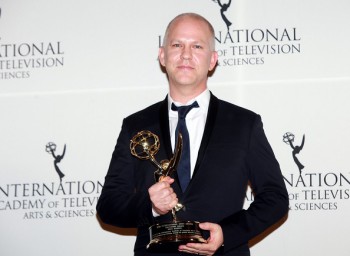
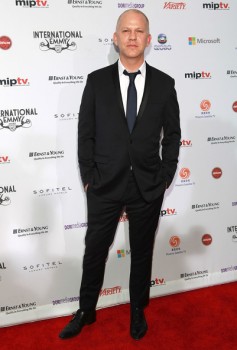
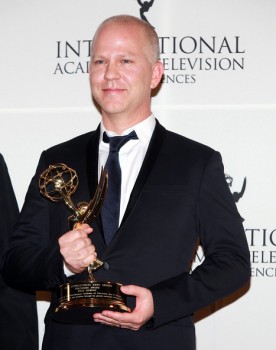
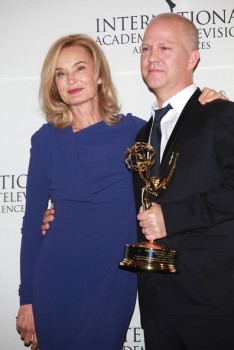
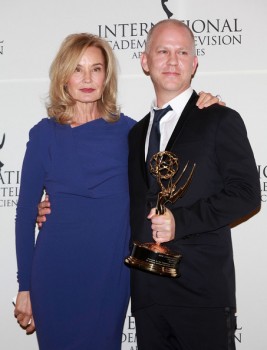

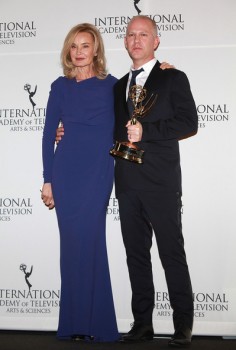
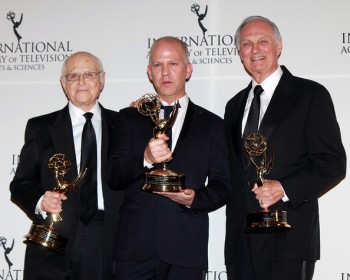
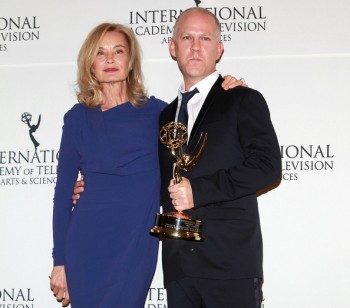
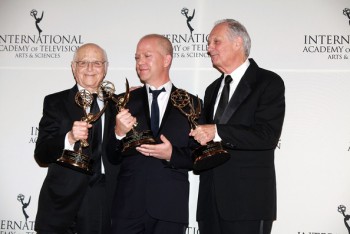
QUEER EYES, FULL HEART: The button-pushing camp of Ryan Murphy.

“The kind of people who always go on about whether a thing is in good taste invariably have very bad taste,” the playwright Joe Orton once wrote. That motto might be stitched into the silk pillowcase of the TV creator Ryan Murphy, whose taste is called into question nearly every week. The provocateur behind Fox’s teen musical “Glee,” FX’s bloody melodrama “American Horror Story,” and NBC’s gay-parent sitcom “The New Normal,” Murphy currently oversees (along with his creative partner, Brad Falchuk) three shows in three genres on three networks. He has two more in the works. He’s also directing a movie version of Larry Kramer’s play “The Normal Heart,” the rights to which he wrangled from Barbra Streisand. Despite Murphy’s productivity, solid ratings, and startling ability to negotiate with personalities as prickly as Kramer and Streisand, he’s never received the godlike worship that other TV auteurs are accorded. By this, I mean men like Louis C.K., Joss Whedon, Vince Gilligan, Dan Harmon, and the HBO Davids-Simon, Chase, and Milch. (With few exceptions, women get a more skeptical reception.) These showrunners may be iconoclasts, but they’ve got gravitas. They wear leather jackets and frowns, or geeky T-shirts and an air of intelligent melancholy.
Murphy, who is openly gay, has an acerbic air, but it’s more in the manner of a gimlet-eyed talent-show judge (a role he played last year, on his reality-TV spinoff, “The Glee Project”). From the perspective of critics and fans alike, Murphy is an irritant, like cayenne pepper: he gets us all excited and then, a season or two in, we’re screaming and gulping down ice water and calling for the waiter. For years, he’s been notorious for constructing fabulous pilots, then driving his inventions off a cliff. Characters get assassinated, literally and figuratively. Sly winks become grand-mal seizures. As anyone who watched the recent disco episode of “Glee,” or Season 6 of “Nip/Tuck”-also a Murphy creation-can attest, this is not an entirely unfair rap. But Murphy is also a pioneer and a radical, worthy of our respect if not precisely our trust: he pushes the limits of television in ways as exciting as anyone up on that Mt. Rushmore of TV. His shows-which by now form a distinct portfolio-need to be considered in their logical framework. That context is not Shakespeare, or Dickens, or even Scorsese, but camp. Realism means little to Murphy; authenticity, less; subtlety, almost nothing. In September, characters on “Glee” took to “hate-watching” David Simon’s “Treme,” and although I’m fond of that series, I laughed out loud. There’s plenty to be said for beauty and dignity. But ugly and brazen have their merits, too.
In 1964, Susan Sontag, in her essay “Notes on ‘Camp,’ ” described it as “a solvent of morality,” and that phrase hints at what is appealing about Murphy’s shows: his Tourettic impulse to offend, even in the midst of the sweetest love story. Camp originated as a private language, in an era when survival as a gay man meant learning to break codes-of male and female behavior, of normality and status. Murphy has taken this vernacular of the closet, and bent it, hard, toward an era of outness. It’s a mighty queer gambit, and one that aligns Murphy with a subset of gay showrunners whom I’ve rarely seen lumped together in critical conversation, perhaps for fear of risking offense.
Among these is Alan Ball, who created “Six Feet Under” (the drama that produced David Fisher, the first truly complex gay male character on TV) and “True Blood” (with its dicey vampirism-as-gay-rights metaphor). There’s also Kevin Williamson, the creator of “Dawson’s Creek” and the new horror show “The Following,” and the executive producer of “The Vampire Diaries”; “Desperate Housewives” ’s Marc Cherry, who named every episode for a Sondheim reference; and Michael Patrick King, the man behind both the exquisitely campy “Sex and the City” and the execrably campy “2 Broke Girls.” In addition, there’s Silvio Horta, the creator of ABC’s sweet telenovela adaptation “Ugly Betty,” an underrated comedy-drama that managed to celebrate both Queens and queens.
Like several of these showrunners, Murphy loves divas and zingers. But he stands out for his aggressive attempts to punch right through TV’s lazier habits, stitching genres together like a mad scientist. Murphy’s finest set pieces evoke Charles Busch and Bertolt Brecht as well as Lady Bunny, theatrical figures willing to risk the ridiculous for a shot at the transcendent. If this approach occasionally results in episodes that resemble the bat-winged pig fetuses from “American Horror Story” ’s experimental lab, so what? Shock has value, too: it wakes us up.
I first discovered Ryan Murphy in 1999, when he created WB’s crass and delirious “Popular.” This was back in the era of “Freaks and Geeks” and “My So-Called Life,” teen dramas that transformed TV with their emotional realism. “Popular” was set in a high school, too, but it had zero interest in nuance. Instead, it presented femininity as a rolling catfight, years before the rise of the “Housewives.” “Popular” also had a knowing surrealism, sharp insights into beauty and power, and outrageous characters, like Mary Cherry (Leslie Grossman), a cheerleader right out of a John Waters film, who was prone to growling phrases like “Shut your dirty whore mouth.” Even before it abandoned coherence, in Season 2, “Popular” injected drag aesthetics into mainstream television like filler into skinny lips. Its specialty was freak-sized emotions-rage, envy, glory-too big to be contained by a subtler genre; in classic camp style, it found ugliness in beauty, as well as vice versa.
The same was true for Murphy’s next show, the plastic-surgery melodrama “Nip/Tuck,” which, starting in 2003, ran for six seasons on FX and ended by alienating practically all its fans. The show’s baroque plot rivalled that of “Flowers in the Attic”: its Wikipedia pages are a cascade of plots like “the three of them create a signature face cream made of semen which they market to Joan Rivers” and “Julia starts an affair with Conor’s dwarf nanny.” Viewers should have been warned by the pilot, which was practically a metonym for the typical Murphy series. It opened with a hideously graphic sequence of a butt implant-a thumb in the eye of anyone who thought he’d be watching pretty people in Miami. During the next forty minutes, the show sketched a smart love triangle among two surgeons-one a moralist, one a womanizer-and the moralist’s wife. It hinted at the potential for a scabrous investigation of our culture’s obsession with perfection, and then, by Act IV, went full-bore outlandish, with liposuction fat spraying everywhere, corpses eaten by alligators, and a torture scene in which a nude surgeon is stabbed with his own Botox needles.
Neither “Popular” nor “Nip/Tuck” reached a mass audience, although “Nip/Tuck” was a hit for FX. Murphy’s breakthrough came in 2009, with “Glee,” a significantly sweeter concoction. The show’s timing was impeccable: in addition to harnessing the phenomenon of “American Idol,” “Glee” became a staging ground for gay rights and the anti-bullying movement. The pilot pioneered the scripted TV musical, inflecting old-fashioned “let’s put on a show” plots with pure Murphy madness-football players doing Beyoncé dances, pinkie-linking lesbian cheerleaders, episodes devoted to “Rocky Horror” and Madonna. If “Popular” was camp for teens, “Glee” added a crucial element: the stylized force of Broadway musicals, where hidden desires could burst out in song.
William McKinley High School, the show’s backdrop, was based on Murphy’s own high school, in Indiana, where he’d grown up as a sharp-tongued, ostracized fashion queen. The characters closest to his heart were Kurt (the wonderful Chris Colfer), whose clear soprano voice shattered the bigotry around him like a champagne glass, and his best friend, the Jewish diva Rachel, a Barbra-worshipping ugly duckling with a crush on a popular jock. By 2009, Kurt wasn’t the only gay teen on TV; there were similar characters on “Ugly Betty” and “United States of Tara.” But, in “Glee” ’s early episodes, Murphy captured something potent: the baby queen’s blend of self-pity and self-assertion, with wounds made into weapons. As “Glee” caught on, Kurt became a bit saintly, but in early episodes he was a moral mixture, at once bully and victim, a character type that became a Murphy specialty.
These Murphy avatars were balanced with a saltier figure: the cheerleading coach Sue Sylvester, played by Jane Lynch, herself an out lesbian. The mistress of cruel nicknames and punch lines like “You think this is hard? Try being waterboarded,” Sue let the show have its cake and eat it, too, sometimes literally-for every fat joke, there was a fat-pride statement. Yet she also cared for a sister with Down syndrome, and mentored a student with the condition. Alone among TV creators, Murphy regularly includes disabled characters in his worlds, sometimes effectively, other times with a queasy mixture of exploitation and bathos; on “American Horror Story,” there’s even a carnival-show pinhead.
There’s a common belief that “Glee” eventually flew off the rails, but really it just became a roller coaster, even within episodes. You’d get clichés and clunkers, or a truly offensive plot, such as the domestic-violence arc that involved the butch Coach Beiste. Then there would be a dazzling black-and-white homage to the Judy Garland Christmas special, meant to be embraced by a select few. This season has been typically uneven, with bland newbies added to the ensemble. Yet the plots set in New York, where Kurt and Rachel have decamped to follow their dreams, still have creamy, glittery, show-biz layers.
The season’s best episode combined three teen breakups: one gay, one straight, one lesbian. The pivotal scene was a callback to Season 2, when Darren Criss, as Kurt’s then crush Blaine, transformed Katy Perry’s hit “Teenage Dream” into a coming-out anthem. Twirling in private-school uniforms, Criss and a chorus of beautiful boys harmonized a cappella, a fantasy of gay male solidarity. Now Criss reprised the song as a karaoke solo, a tearstained confession about the death of first love-of their relationship, and, in a sense, of the show itself. Four seasons in, long after many viewers had given up, “Glee” hit a high note again, its own artificiality serving as a frame for real feeling.
Murphy once described his inspiration for “American Horror Story” by saying, “I can’t write any more nice speeches for these ‘Glee’ kids about love and tolerance and togetherness. I’ll kill myself.” Instead, he built a stage for perverted nightmares, with a pilot designed to offend. In it, an estranged couple, the Harmons (Connie Britton and Dylan McDermott), move to Los Angeles, and, in grand horror tradition, buy a cursed mansion (it’s a stop on a Hollywood “Murder Tour”). After a bout of reconciliatory sex, Britton lounges in their bedroom. Then her husband returns-or, at least, she assumes it’s him. It’s hard to tell, since he’s in a black leather gimp suit. “You really want to go for round two?” she says, in a nervous voice. “C’mon, I can be kinky.” What follows might be described as quasi-consensual gimp-rape, with Britton staring into devilish eyeholes, the camera swooping in voyeuristic delight. The scene felt like a valentine to seventies horror films, those juicy, unpretentious slices of psychosexual pulp, which drew little division between fantasy and fear. Like camp, they were somehow at once misogynist and feminist, a tacky aesthetic with a special potency, perfect for exploring taboo themes about feminine strength and vulnerability.
The first season of “American Horror Story” played, at its best, like the anxious fever dream of a woman approaching menopause. Betrayed by her husband, Britton gets knocked up by the Devil, and her aging body becomes the show’s haunted house, prey to assault and invasion, tormented by ghosts of tabloid murders past and present. Meanwhile, her teen-age daughter is seduced by a ghost, then becomes one. In the show’s most remarkable performance, Jessica Lange swans about as Constance Langdon, an iconic Murphy diva-she’s an elderly bigot and a glamorous truthteller, as well as the mother of monsters. One son was a mass murderer; another was a genetic anomaly. Langdon’s daughter has Down syndrome, a circumstance treated with Murphy’s trademark blend of shock and pathos. The show ended with a subtly conservative coda: the now dead Harmons unite by the Christmas tree, while an ensemble of childless, deviant ghosts hovers enviously in the shadows. Yet the season, for all its gimmicks and its bratty air of overkill, felt coherent, as a nightmare does, the best bits indelibly sad.
The second season (subtitle: “Asylum”) abandons that story, and it gets better. It’s set in a mental institution in the early nineteen-sixties, with much of the same cast, in different roles. This is Murphy’s solution to an ongoing TV problem: by reviving the “anthology” series, he avoids the danger of a great show losing its edge. Lange is back, as another tormented tormentor: Sister Jude, a nun with a working-class Boston accent and a selection of riding crops. She’s determined to force “productivity, prayer, and purification” on her patients, but she’s also a woman with a past and, in her way, an independent mind. There’s also Chloë Sevigny as a nymphomaniac, Lily Rabe as a novice nun, Sarah Paulson as a lesbian investigative journalist, and James Cromwell as a scientific sadist named Dr. Arden. It all conjures “Dark Shadows”-the gothic soap that Murphy watched as a child-and the great pre-gay-rights pulp lesbian novels, paperbacks with titles like “Odd Girl Out,” which drew no bright line between politics and pornography.
On adult cable, Murphy and his writers deliver dialogue that makes you gasp and giggle. A kinky psychiatrist demands of a terrified hooker, “Slowly. Show me your mossy bank.” When a possessed farm boy taunts Lange’s nun, he sneers, drawing the words out like Snidely Whiplash, “It drives you cra-a-azy. To be the smartest person in the room, with no real pow-w-wer. Because of that smelly clam between your legs.” When the good Dr. Thredson-played by Zachary Quinto, like Paulson an openly gay actor-arrives at the asylum, he’s astonished. “Your hospital still administers electroshock to homosexuality; it’s barbaric,” he declaims prissily. “Behavior modification is the current standard.” Lange purses her lips and shoots back, “Tomato, tomahto.”
“American Horror Story” revels in live-wire debates, like faith versus science. But the show’s real achievement is the verve with which it dives into the kitsch depths of Freudian and Catholic repression, finding ugly links among disparate types of torture: medical, religious, political. Visually, the show is equally audacious, lingering on a black-and-white wimple that frames red lipstick, then pulling classic horror-flick fakeouts, or turning a flashback into newsreel footage. In a standout episode, the asylum hosts a movie night, which takes on a self-referential feel. “We’re all going to be together in the dark, watching ‘The Sign of the Cross,’ a movie full of fire, sex, and the death of Christians,” a nun, who happens to be possessed by Satan, purrs. “What fun.” Then Sister Jude, who is drunk on Communion wine, introduces the film, making reference to “the incomparable Mr. Charles Laughton, who I understand is an enormous whoopsie.” This spins, somehow, into a spoken-word rendition of “You’ll Never Walk Alone.” It’s pure camp, and also quite moving, and unlike anything else on TV.
Loving a Ryan Murphy show doesn’t always mean enjoying it. Parts of “American Horror Story” make me ill or angry; other parts turn me on, or make me laugh, in a way that may not be intentional-though, as with “Louie,” the show’s inconsistency can’t be unstuck from its appeal. (There are lines that suggest a vaudeville joke: “Doctor, do you have something for a headache?” “Yes. Take this hammer and hit yourself on the head.”)
Two weeks ago, Murphy made his most brazen move: he added Franka Potente as an inmate who claims that she’s Anne Frank, all grown up. She identifies Arden as a Nazi scientist, and, when she escapes his clutches, she becomes, for a moment, a version of the “Final Girl” described by the film theorist Carol Clover-the terrorized female who survives every horror movie, then tells the world what has happened to her. Then, in the next episode, “Anne Frank” is revealed to be someone quite different; and, in a horrifying turn, it’s the lesbian reporter who becomes the final girl.
My gorge rose as I watched Auschwitz flashbacks and scenes set in a serial killer’s torture chamber; I felt disturbed to the point that I hit Pause to collect myself. But by the time it ended I was convinced that “Asylum” might be Murphy’s masterpiece: radical art that aims for the body as well as for the mind.
I’d love it if this were also true of “The New Normal,” Murphy’s first network comedy, particularly since he clearly intends for the show to have an impact, both as politics and as gay representation. As with “American Horror Story,” he’s drawn his inspiration from the seventies-this time from abrasive political sitcoms, like “All in the Family.” Norman Lear is his hero, he has told critics.
Like “Glee,” “The New Normal” features a character based on Murphy: Bryan (Andrew Rannells), the creator of a TV show called “Sing.” Justin Bartha plays his partner, David, a sweet doctor. Georgia King is Goldie, the Midwestern girl who becomes their birth surrogate; Bebe Wood is her eccentric child. Ellen Barkin plays Goldie’s mother, Nana, an Archie Bunker type who rants about “salami smokers.” (She’s based on Murphy’s eccentric grandmother, who raised him while Murphy’s mother, a beauty queen, worked.) There’s also Bryan’s assistant, Rocky, played by the charismatic “Real Housewives of Atlanta” star NeNe Leakes, who also appeared on “Glee,” as Black Sue.
It’s easy to make the abstract case for “The New Normal,” which is that it’s refreshing to have a liberal sitcom go for the jugular. Strange is better than dull. But, while I try not to judge sitcoms before the first six episodes have aired-they’re the burnt-on-the-outside trial pancake of comedy-so far “The New Normal” works mostly in theory. As game as Barkin is, Nana’s abrasiveness feels contrived. Worse, the show’s air of rich-white-gay-guy L.A. privilege curdles punch lines that might play in “Glee” ’s more modest Lima, Ohio. Last year, Michael Patrick King defended “2 Broke Girls” against accusations of racism by saying that, as a gay man, he was free to be an equal-opportunity offender. It’s an excuse that doesn’t hold up, and “The New Normal” has some similar cruel-queen tendencies, and without the ameliorating factor of “Glee” ’s musical numbers.
Some bits do pay off, like Wood’s imitation of the “Grey Gardens” camp icon Little Edie. There was a melancholic force to the episode when Nana had her first orgasm. Yet, in Episode 7, when Bryan goes to church to find a godfather for his unborn child, a promising debate just fizzles. “Oh, the Pope. Come on,” the priest scoffs. “Haven’t you ever had a lovable old uncle who popped off intolerant comments at a family barbecue?” The resolution to the couple’s search for spiritual guidance made me wince: Rocky, already a TV stereotype as Bryan’s sassy black helpmeet, was selected as the unborn child’s wise godparent, another cliché. There was even a wry remark about Maya Angelou, as if acknowledging a cliché were the same as defanging it.
It’s hard to say why Murphy’s shows are so inconsistent: TV is a collaborative art form, after all, with Murphy’s wild ideas mixed in with those of Falchuk and other writers. But his inconsistency is a price worth paying. Like political activism, television needs its radicals, as well as those who work within the system. Asked by Vogue about his admiration for Larry Kramer, Murphy said that he identified with “that sweet, necessary concept of protest and anarchy.” A show like “American Horror Story” may breach the borders of what others consider good taste, but it burns a path to something wilder. “The New Normal” is a misfire, but at least it’s not a boring one. And “Glee”? Oh, “Glee” is a royal mess. But I am still watching “Glee.” I will always be watching “Glee,” even as I judge and judge. As Oscar Wilde put it-and I’m fairly certain that Sue Sylvester would agree-“True friends stab you in the front.” ♦
newyorker.com